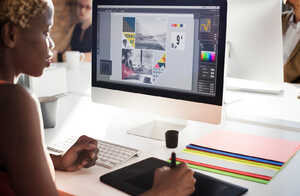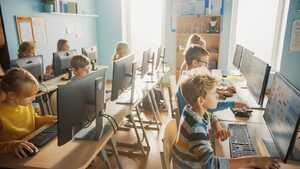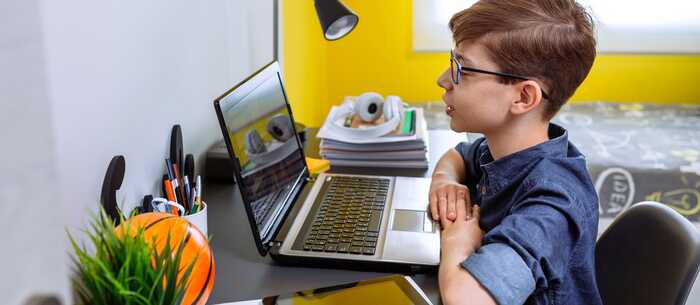Given how much weight academic institutes in the UK place on the STEM fields, you’d be forgiven for thinking that the arts and cutting-edge technology might occupy entirely different spaces on the education spectrum.
The modern art student, however, is learning how to combine their creative talents with technology to engender new possibilities within the subject, exploring complex ideas and revolutionary techniques.
The movement to change STEM to STEAM – with the arts adding the vital ‘A’ to science, technology, engineering and maths – is one that’s gathered significant momentum in recent years. Whether that’s local primary schools investing in modest art software packages, or the Royal College of Art in London building entire learning hubs where art, design and architecture meet science, technology and artificial intelligence – the art classroom will never be the same again.

Embracing technology in the arts
Student artists of all ages are already highly proficient at using tablets and phones to draw, sketch, shade, and paint. For art teachers, whose aim is for technology to encourage and nurture students’ contemporary learning skills, there is an evident willingness to embrace this new classroom model. Indeed, according to latest State of Education report compiled by the National Education Union, 81% of art teachers believe that technology has a positive impact on students' creativity, enabling them to explore new artistic possibilities and techniques.
Meanwhile, the UK government have made clear the value they place on this technology revolution within the art classroom. In their National Plan for Cultural Education, they outlined the importance of integrating technology to enhance access, engagement, and creativity in arts subjects, including the visual arts.
So far, so good. But what exactly do we mean by integrating technology into the art classroom? Let’s take a look at some of the ways in which traditional education spaces have embraced the power of technology.
Digital art tools
Conventional art supplies such as paintbrushes, canvases, and clay can now all be used alongside sophisticated digital drawing tablets, graphic design software, and 3D modelling tools. These digital resources can provide students with a much broader scope of artistic experience, allowing them to experiment with different techniques, styles, and art forms. Digital art tools also offer the advantage of an endless bank of undo/redo options, giving students the creative license to explore and correct their mistakes without the fear of ruining their work.
Meanwhile, modern drawing tools are helping students learn a variety of fundamental art principles, like depth and space, perspective, colour value and 3D forms. In this article published by the global technology provider Acer, the accessibility and legitimacy of these digital tools were already demonstrably clear:
“With a few clicks of a mouse can create more precise shapes and brushstrokes than a budding digital artist could produce if given a physical palette and brush, and there is no reason why the final result should not be considered real art.”
Virtual Reality (VR) and Augmented Reality (AR)
Virtual reality and augmented reality technologies have opened up an entirely new paradigm for art education. Through VR headsets, students have the potential to immerse themselves in virtual art galleries, visit museums worldwide, and even step into historical periods to experience art movements firsthand. AR technology, meanwhile, has the ability to overlay digital elements onto real-world environments, enabling students to superimpose their artwork onto physical surfaces or interact with virtual objects. These immersive technologies enhance engagement, deepen understanding, and create a sense of wonder and exploration among students.

Online art communities and collaboration
The internet has given rise to vibrant online art communities where students, artists, and educators can connect, share their work, and collaborate on projects. Platforms like Behance, DeviantArt, and ArtStation provide a space for students to showcase their creations, gain feedback from peers and professionals, and draw inspiration from a diverse range of artistic styles. Through virtual collaboration, students can work together on art projects, exchanging ideas and techniques in real-time. This global connectivity expands their horizons and exposes them to a wealth of creative perspectives.
Interactive whiteboards and projectors
Interactive whiteboards and projectors have transformed the way art lessons are delivered in classrooms. Teachers can project high-resolution images and videos onto large screens, enabling students to analyse and critique artwork in granular detail or study specific artistic techniques. Interactive whiteboards allow students to annotate, draw, and interact directly on screens, encouraging active participation and nurturing a more dynamic learning environment. These technologies can facilitate interactive discussions, group activities, and real-time feedback, enhancing students' comprehension and critical thinking skills.

Online art courses and tutorials
Technology has made high-quality art education accessible to a wider audience through online art courses and tutorials. Students can now learn from renowned artists and educators from around the world, regardless of their geographical location. Online platforms such as Skillshare and Udemy offer comprehensive art courses covering various disciplines, including painting, drawing, sculpture, and digital art. These platforms provide step-by-step tutorials, video demonstrations, and personalised feedback, helping students to develop their artistic skills at their own pace.
The limitations of art technology
As with any technology integration, there are a number of challenges schools must navigate to truly realise the potential of creating an ICT-friendly art space. Unfortunately, when it comes to pinpointing these limitations, we encounter some familiar themes:
Cost and accessibility
Integrating technology in the art classroom can be costly. High-quality digital tools, software licenses, and hardware upgrades can put a strain on a school’s budget, and there might naturally be some resistance from stakeholders to divert funds into non-STEM subjects. Equally, not all schools may be afforded access to technology due to a poorly managed, or lack of ICT infrastructure.
Technical challenges
An inadequate IT estate can also present technical challenges that can disrupt the learning process. Software glitches, connectivity issues, or hardware malfunctions can hinder students' ability to fully engage with digital art tools. These technical difficulties can consume valuable instructional time and cause frustration among students and educators.
Loss of hands-on experience
Traditional art techniques often involve tactile experiences and physical manipulation of art materials. While digital art tools provide new possibilities, they may not fully replicate the sensory experience of working with traditional mediums. Some students may miss the hands-on exploration and textural qualities associated with traditional art forms.
Teacher training and support
Integrating technology effectively requires teachers to have a solid understanding of both art pedagogy and the specific technology being used. Ongoing professional development opportunities, ICT support and training are crucial to ensure that teachers feel confident in utilising technology to enhance art education.
How can Computeam help?
Technology has revolutionised art education by transforming art classrooms into dynamic and interactive spaces that foster creativity, collaboration, and skill development. From digital art tools and virtual reality experiences to the wealth of educational value found in online communities, technology allows students to explore artistic expression and engage with the art world on a global scale.
Here at Computeam, we recognise the transformative impact that technology has had on the art classroom, and by providing schools with cutting-edge hardware, software, and digital resources, we will continue to help schools unlock the full potential of their students' artistic abilities. If you’d like to find out more about how technology can transform your school’s art classroom, please do get in touch.

Computeam on... Is the Blended Learning Model the New Normal?
Read about the role of the hybrid classroom and the concept of blended learning.



 Learning Locker
Learning Locker Climate project
Climate project